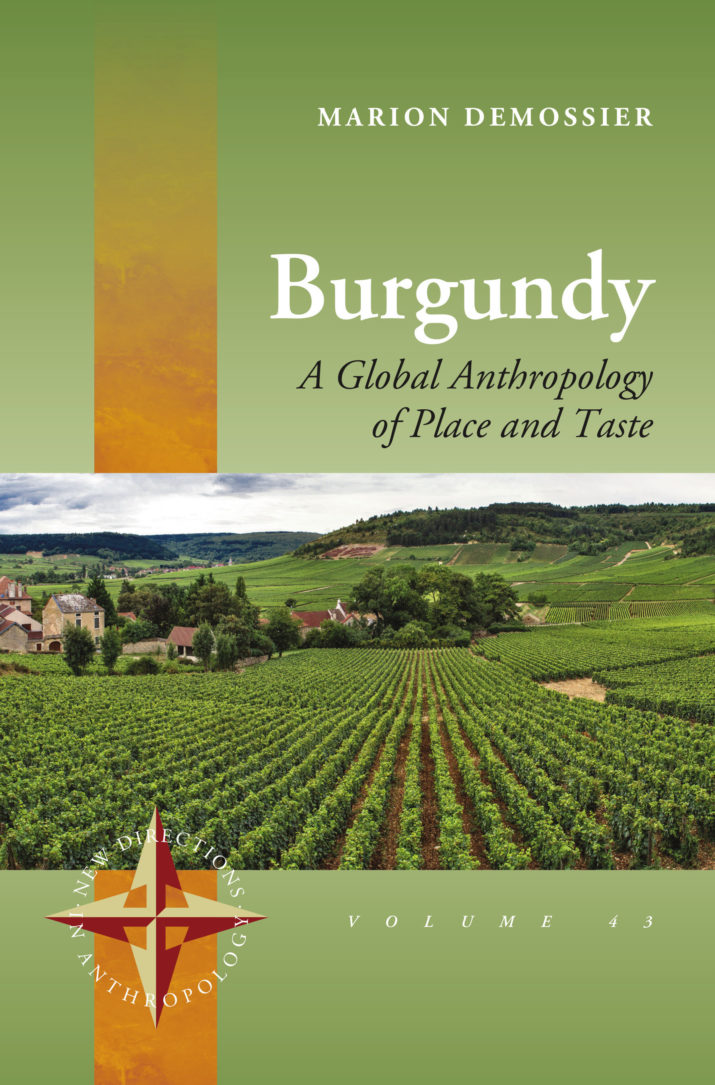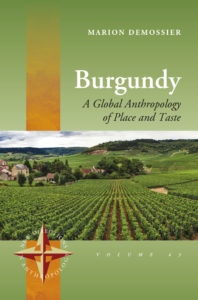
 The qualities of wines have been linked to their places of origin for millennia, though perhaps never with such enthusiasm as in the twenty-first century. This link between place and taste—for which the French term terroir has become global shorthand—provides the ethnographic window for Marion Demossier’s latest book on her work Burgundy: an ambitious and comprehensive account of regional winemaking that draws from more than three decades’ experience in-location.
The qualities of wines have been linked to their places of origin for millennia, though perhaps never with such enthusiasm as in the twenty-first century. This link between place and taste—for which the French term terroir has become global shorthand—provides the ethnographic window for Marion Demossier’s latest book on her work Burgundy: an ambitious and comprehensive account of regional winemaking that draws from more than three decades’ experience in-location.
In the first chapter, Demossier explores the construction of locality in Burgundy. This takes on a geographical theme as she unpacks the history of vineyard demarcations (Grand crus, Premiers crus, villages) and other iterations of origin appellation. In this chapter, we learn that the diversity and distinction are foregrounded in contemporary wine geographies; thus, the landscape takes center stage in claims of quality. In Chapter Two, Demossier shifts her focus to the role of the winegrower in Burgundy. While most terroir literature to-date is fixed on debates around terroir as natural or cultural, her analysis situates the producer as the negotiator at the heart of all terroir components, mitigating such factors as soil, climate, and local knowledge (from vineyard management to marketing know-how).
The complex topics presented in some chapters are felt to be deserving of their own volumes. I sensed this most in Chapter Three, which addresses the position of taste as a linkage between people and place in Burgundy. From local quality-defining groups in the fourteenth century to the contemporary Appellation d’Origine Controlee (AOC), Demossier outlines the evolution of taste as the “monolithic” evaluation of terroir products. Especially enticing in this chapter is the role of the new regime of expertise that arrived in the 1990s, which allowed for the mapping and “gustatory reading” of each AOC. This modern appraisal of the landscape has given character to winemaking terroirs, rendering their ahistorical qualities legible.
In Chapter Four, Demossier explores the construction of Burgundy as the global epicentre of quality wine. Referencing the literature of renown wine writers and publications, she argues that the literary construction of Burgundian wines provides a foundation for discourses of quality in Burgundy and beyond as they construct “imaginary worlds of taste.” Chapter Five revisits several of the themes in Chapter Two as it moves “beyond terroir.” Here, Demossier introduces us to Burgundy’s producer-elites, who strategically redefine their wines through discourses of ecologically friendly production methods. In this sphere, social and technological influence is downplayed as “nature” is foregrounded in unique wines. In doing so, these elite wines provide a distinctly Old World counterpoint to New World products, which are presented as mass-produced through uniform technological methods.
Chapters six and seven serve, perhaps more than the others, as an update and expansion to Demossier’s earlier work on terroir in Burgundy as she enlarges her field, including vignettes from Japan and New Zealand to examine the use of terroir as a “strategic European tool” and as marketing strategy that depends on connections between experiences and discourses that link place, producers, and consumers with fascinating comparative examples from the Far East and Australasia. In the final chapter, Demossier follows Burgundy’s (unsuccessful) UNESCO World Heritage campaign, tracing the project from its emergence to present-day (Demossier herself was invited to contribute to the definition of climats de Bourgogne). Here, she introduces the development of climats de Bourgogne as Burgundy’s own sites of terroir with unique physical properties and associated tastes.
Together, these chapters illustrate many facets of a central theme: the situating of quintessentially local practices, places, and producers as concurrently global actions, spaces, and actors. In their winemaking, Burgundian producers are acting in response to trans-national and historical forces—from global markets to climate change—and shaping their worlds and livelihoods accordingly. This resonates with broader conversations within the anthropology of food around distinctions between consumption- and production-oriented studies. Rejecting this dichotomy, if mostly implicitly, Demossier follows through convincingly with her claim: “it is by following both producers and products into their wider connections and circulations that I see them becoming ethnographically meaningful” (9). She eschews another dichotomy dominating terroir literature through her analysis of the phenomenon as simultaneously socio-ecological, although tensions between her interlocutors’ conceptions of terroir as predominantly social or natural could be further scrutinized. For example, UNESCO’s enlistment of vineyards—as anthropogenic landscapes—as heritage sites is contradicted by the same organization’s appointment of physical scientist as the international chair for wine culture and tradition. Contradictions like these could frame interesting discussions of material geographies and valorized distinction, particularly as authentic tastes “[claim] to be closer to nature and the soil” (121) and follow the trend toward “letting the terroir speak” (156).
As Demossier explains, it is the value of authenticity—heightened within globalized capitalism—that motivates collective identities in Burgundy as they are linked to places and pasts. Today, she further observes, authenticity is constructed through encounters with the site of production and notions of nature and ecology. As such, Burgundy’s status as elite in the global wine world suggests the utility of a more critical approach to origin labelling and the valorization of landscapes as heritage, where anthropology is “a science of critique and not a contributor to myth-making” (10). As Demossier asks early in the book, “Why are the great vineyards of France located where they are?” (15). While she is cautious of the “fossilization” of power relations in terroir landscapes (and the tendency for wealthy elites to capitalize on their self-defined notions of quality), Demossier’s provocative question may find more satisfyingly critical perspectives in the analyses of non-French places-of-taste, such as Brabazon’s (2014) postcolonial White Burgundy in Australia, or Jung’s (2014) political economy of taste and the “unknown terroir” of post-socialist Bulgaria. Rather than taking for granted the centrality of French vineyards as epicentres of quality, these examples destabilize the singularity of terroir as French and subvert its associated gustative norms: even Burgundy’s newly adopted climats find equally historic analogues outside of France (in the Hungarian dűlő, for example).
Anthropologists will appreciate Demossier’s personal and reflexive voice, for example, as she candidly admits the cynicism with which she is sometimes met when describing her fieldwork to colleagues (as wine studies are relegated to “soft anthropology”). However, there is nothing “soft” about Demossier’s data-driven, detail-laden ethnographic narrative. Ultimately, her work is not only about the locality of her informants, but also of the ethnographer; Demossier’s long-term commitment to the Burgundy project has granted her—and thus, this monograph—the unique outlook afforded by ethnographic location and “anthropology at home.” Demossier’s position—as an insider with an outward gaze—has afforded us a wide-ranging, quintessentially anthropological account that grounds global forces in ultimately local places and products.
Burgundy speaks to a variety of issues beyond winemaking and will be of interest to many scholars working in other fields. Through her innovative approach to “global anthropology,” Demossier contributes to broader debates within food studies, globalization/global capitalism, and geographies of heritage and would be appreciated by an interdisciplinary audience as much as by fellow anthropologists.
Reviewed by June Brawner, The University of Georgia
Burgundy: A Global Anthropology of Place and Taste
By Marion Demossier
Publisher: Berghan Books
Hardcover / 280 pages / April 2018
978-1-78533-851-9
Published on November 8, 2018.
To read more reviews click here.
Works Cited:
Brabazon, Tara. “Colonial control or terroir tourism? The case of Houghton’s White Burgundy.” Human Geographies 8.2 (2014): 17-33.
Jung, Yuson. “Tasting and judging the unknown terroir of the Bulgarian wine: The political economy of sensory experience.” Food and Foodways 22.1-2 (2014): 24-47.




